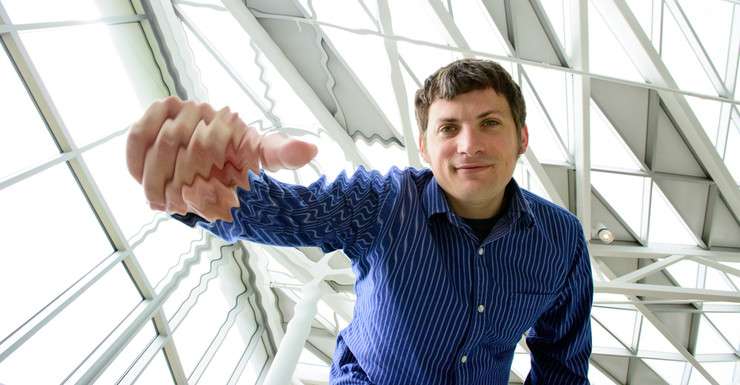Making waves in spacetime

Waves on Earth's oceans move in endless rhythm along sandy beaches. Another kind of wave ripples to our planet from distant black holes in the universe.
Less than four months after the historic first-ever detection of gravitational waves, scientists on a team that includes Penn State physicists and astronomers detected another gravitational wave washing over the Earth.
"I would never have guessed that we would be so fortunate to have not only one, but two definitive binary black-hole detections within the first few months of observations," said Chad Hanna, an assistant professor of physics, and astronomy and astrophysics at Penn State.
Hanna also co-chairs the Compact Binary Coalescence Group of the Laser Interferometer Gravitational-wave Observatory (LIGO), which detected both the first gravitational wave and the new one since beginning observations this past fall.
Both of the gravitational waves that have been detected were born during the final moments before two massive black holes merged into one.
This gravity-driven merger warped space and sent waves speeding outward, making ripples in the fabric of spacetime. Before the first indication by LIGO, these waves had not ever been detected on Earth.
"We now have far more confidence that mergers of two black holes are common in the nearby universe," Hanna said. "Now that we are able to detect gravitational waves, they are going to be a phenomenal source of new information about our galaxy and an entirely new channel for discoveries about the universe."
Physicists have concluded that the newly detected gravitational-wave event was produced during the final moments of the merger of two black holes whose masses were notably smaller than the masses of the black holes whose merger produced LIGO's first detection. This new merger united black holes with masses 14 and 8 times the mass of the sun, producing a spinning black hole that is 21 times the mass of the sun.
"It is very significant that these black holes were much less massive than those in the first detection," said Gabriela Gonzalez, professor of physics and astronomy at Louisiana State University, spokesperson of the international LIGO Scientific Collaboration (LSC), and a former assistant professor of physics at Penn State.
"Because of their lighter mass, they spent more time—about one second—in the sensitive band of the detectors. It is a promising start to mapping the populations of black holes in our universe."
Hanna said, "I don't think the average person stops to think too much about what space and time are. But when we tell them that we're absolutely sure that the space around them, everywhere, is wiggling about because somewhere distant in our universe, a black hole has merged, I think that will send a pretty profound message to, hopefully, everyone about just how cool a place our universe is."
The first detection of gravitational waves, which occurred in September 2015 and was announced on February 11, 2016, was a milestone in physics. It confirmed a major prediction of Albert Einstein's 1915 general theory of relativity, and marked the beginning of the new field of gravitational-wave astronomy. The new gravitational waves were detected on December 25, 2015, at 10:38:53 p.m. U.S. Eastern Standard Time by the twin Advanced LIGO detectors—one in Livingston, Louisiana, and the other in Hanford, Washington.
During the merger that produced the new gravitational-wave event, which occurred approximately 1.4 billion years ago, roughly the equivalent of the mass of our sun was converted into gravitational waves. The detected signal comes from the last 27 orbits of the black holes before their merger. LIGO's Livingston detector measured the waves 1.1 milliseconds before LIGO's Hanford detector. The different arrival times of the signals gives a rough idea of the position of the source in the sky.
"It will be exciting, as we get more detections and do further analyses in the years to come, to disentangle the clues about where these black holes come from," Hanna said.
"Unlike the first wave we detected last fall, this new wave had an amplitude that was significantly below the detectors' noise level," he said. "We were able to detect this wave because we used the sophisticated techniques that our research field has been developing for decades."
The gravitational waves that are passing through the Earth now are, in effect, stretching and squeezing the Milky Way galaxy into a very small width, Hanna said.
Gonzalez said, "I was very proud seeing Chad Hanna co-leading the group that found the detection, and being one of the main authors of the fast analysis that will allow multi-messenger astronomy."
David Reitze, the executive director of the LIGO Laboratory, said, "The Penn State Gravitational-wave group, led by Chad Hanna, was right in the heart of LIGO's second detection. The analysis codes developed by Chad and his group identified the gravitational wave within a few minutes after it was detected by the LIGO interferometers. This ability to identify gravitational-wave event candidates on short-time scales is the key to one of LIGO's primary science goals in the future—joint observations of high-energy astrophysical phenomena with LIGO and electromagnetic telescopes."
Hanna said, "Our experience with this new black-hole binary gives us confidence that we can detect—in near real-time with our present techniques—systems with very small amplitudes as we expect for binary neutron stars. We now have good reason to believe that the future for gravitational-wave astronomy and multimessenger astrophysics is bright."
Provided by Pennsylvania State University





















